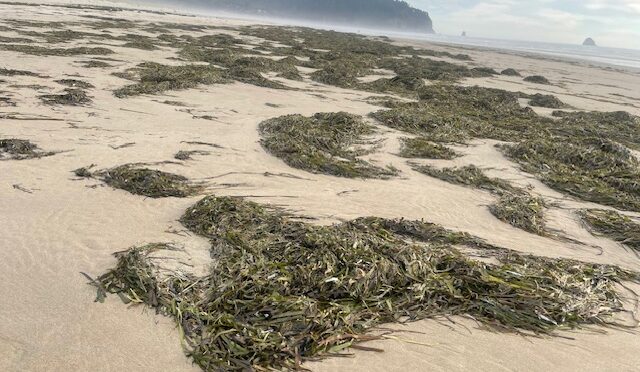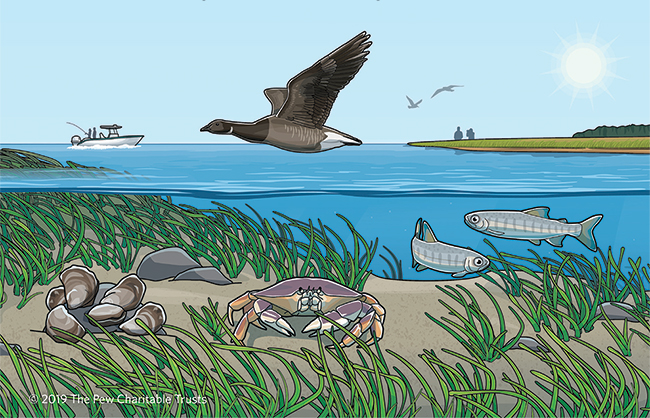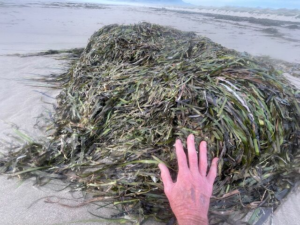Visitors and residents have expressed concerns about the mounds of eelgrass washing up on Cape Meares Beach. Lush meadows of eelgrass (also known as seagrass) are prevalent in the shallow areas of Tillamook Bay. As a keystone species, the eelgrass provides vital habitat. The question on the minds of longtime residents is why is there so much fresh green, and even rooted, eelgrass washing up on the beach? Long-time residents recount that this was not always the case, and concerns were raised about the possible explanations for the change. These questions and other eelgrass die-off events triggered local action to study the issues and take any necessary actions to protect vital and fragile eelgrass habitats. Scott Gordon and other members of the Cape Meares community are collaborating with Tillamook Bay Estuaries Partnership, Oregon Shores Conservation Coalition, and Coastal Conservation Association to research the history and current status of eelgrass in Tillamook Bay and to identify conservation strategies.
Tillamook Bay Seagrass Baseline Assessment November 2025
CMCA Support for Eelgrass Protection HB3580 February 2025
Eelgrass Is Essential to Ocean Health | The Pew Charitable Trusts
6 Reasons to Protect Eelgrass
- Protects coastlines
Eelgrass helps stabilize the shore in addition to furnishing habitat for a variety of marine wildlife. - Mitigates climate change
Eelgrass absorbs carbon dioxide and methane — climate-warming greenhouse gases — and stores them in its root system. - Nurtures fish
Eelgrass beds provide shelter and foraging areas for rockfish, salmon and Dungeness crabs. - Feeds birds
Migratory waterfowl, including the Pacific black brant, eat eelgrass. - Improves water quality and clarity
Eelgrass beds absorb pollutants and help prevent harmful algal blooms. - Strengthens the coastal economy
Eelgrass supports fish and shellfish that are integral to the commercial and recreational fishing industries.
The Cape Meares Community Advocates for Eelgrass Protection
Protecting Salmon Smolt from the Threats of Mechanical Oyster Farming
“Tillamook Bay, Oregon, is a unique and dynamic ecosystem where five rivers converge, creating an essential habitat for anadromous fish, like salmon and steelhead. These rivers— the Wilson, Trask, Tillamook, Kilchis, and Miami—support annual runs of salmon and steelhead, including the threatened Coho salmon, which is listed under the Endangered Species Act (ESA). For decades, conservation efforts have focused on restoring upstream spawning areas in an attempt to bolster dwindling populations. However, the vital journey these fish take is not just limited to their time in rivers and streams; the health of the bay itself is equally critical for their survival.
In recent years, the expansion of mechanized oyster farming in Tillamook Bay has raised serious concerns regarding the health of this delicate ecosystem, particularly in relation to eelgrass beds, which serve as critical nursery habitats for juvenile fish, or “smolts,” as they transition from freshwater to the open ocean. The mechanical harrowing and dredging associated with oyster farming is damaging these eelgrass beds, threatening not only the bay’s ecological balance but also the survival of salmon and steelhead populations. Protecting these eelgrass meadows must be a priority if we are to ensure the long-term sustainability of both the bay’s aquatic life and its economic benefits.” Scott Gordon, Cape Meares Resident.
Tillamook Estuaries Partnership Planning for Reliance – Eelgrass Monitoring Program



